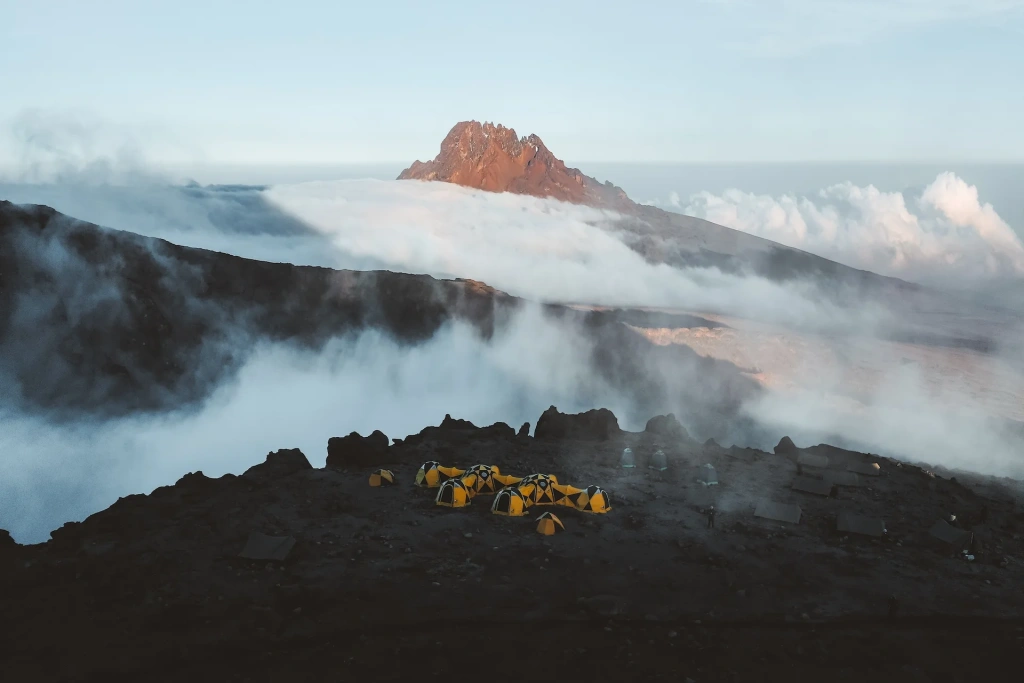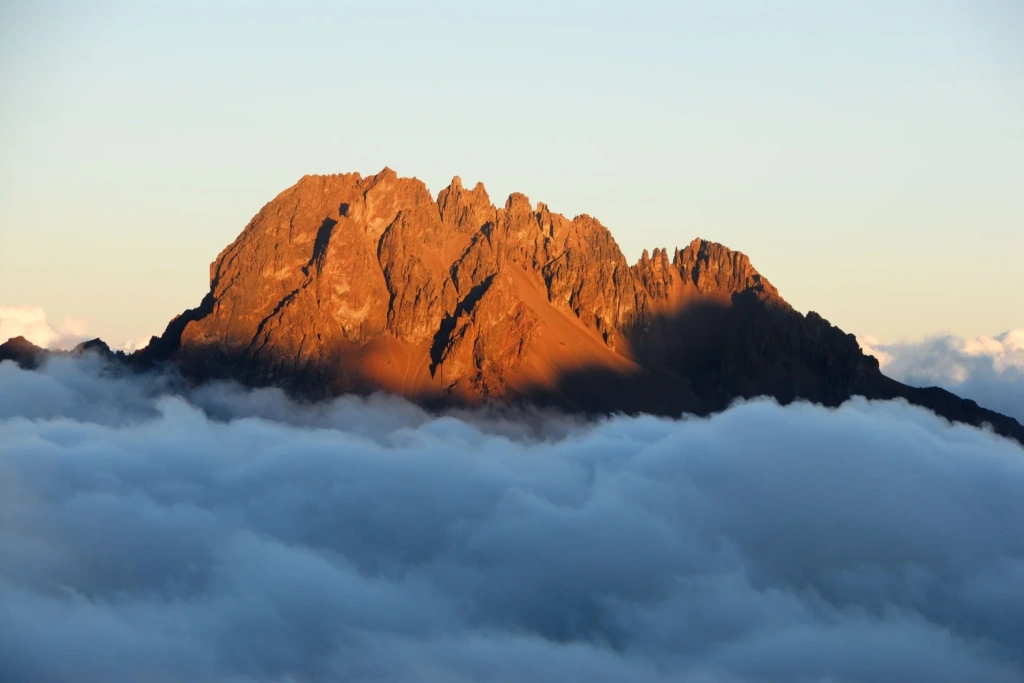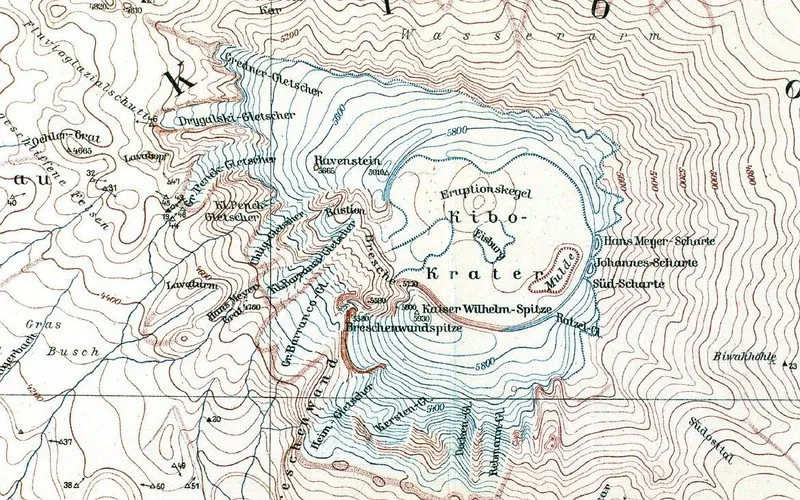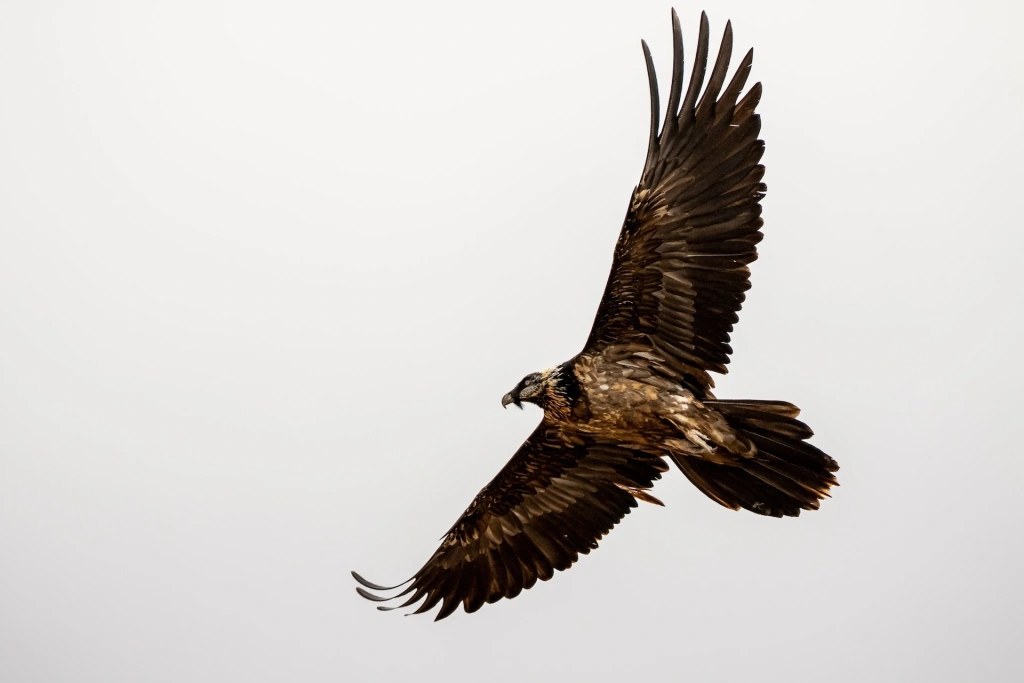Mawenzi is one of three volcanoes that make up the Kilimanjaro massif, along with Kibo and Shira. While it's a key component of Africa's highest mountain, it often gets overshadowed by its older brother, Kibo, and isn't as well-known on its own. Depending on the route you choose and the weather conditions, you are very likely to see Mawenzi Peak on your Kilimanjaro climb.
In this article, you will learn where Mawenzi is located, what makes it remarkable, its height, and the history of ascents on this volcano. You will also learn what creatures call this mountain home.
Where is Mount Mawenzi located?
Mawenzi is located 340 kilometers (211 miles) south of the equator in Tanzania. The mountain is part of a protected area—the Kilimanjaro National Park—making it difficult for just anyone to get close to it. Mass ascents of Mawenzi Peak are out of the question, and the climbing routes on Kilimanjaro typically lead to the summit of the neighboring Kibo volcano.
Mawenzi is a volcano that erupted about one million years ago. Following a secondary eruption and heavy erosion, its cone fractured, and much of the softer rock was eroded. What’s left today are jagged peaks and sharp formations of solidified lava.
Only experienced mountaineers should attempt climbing Mawenzi. However, even for them, the ascent can be risky. The park authorities allow only experts with the right equipment to climb Mawenzi Peak, and only if they are accompanied by skilled guides who know the mountain well.
How high is Mawenzi Peak?
The main summit, which makes Mawenzi the third-highest peak in Africa, is 5,149 meters (16,893 feet) above sea level. It is named Hans Meyer Peak, in honor of the first person to successfully reach the highest point of Mount Kilimanjaro—Uhuru Peak, which stands at 5,895 meters (19,340 feet) on Kibo. However, Meyer's attempts at climbing Mawenzi were unsuccessful, illustrating the difficulty of ascending this formidable summit.
If we consider it , its height would place it in a notable third position among the top ten highest mountains in Africa. It would trail Mount Kenya (5,199 meters or 17,057 feet) by just 50 meters (165 feet).
Are there other peaks on Mawenzi?
In addition to Hans Meyer Peak (and Oehler Buttress to its west), there are several notable summits:
- Nordecke (5,136 meters or 16,850 feet), with North East Ridge, North Spur, and North West Ridge
- Purtscheller Peak (5,120 meters or 16,797 feet), named after Ludwig Purtscheller, the climbing partner of Hans Meyer, with its West Ridge
- Borchers Peak (5,115 meters or 16,780 feet), named in honor of the sponsor of the 1938 expedition
- Klute Peak (5,096 meters or 16,750 feet), named after Fritz Klute, the first ascender of the mountain, with Middle Buttress in the East
- Latham Peak (5,087 meters or 16,690 feet), named in honor of Dr. Donald Latham, the explorer and physician
- Londt Peak (4,945 meters or 16,227 feet), named after the South African climber George Londt, with South West Ridge, Londt's Ridge, South Ridge, South East Ridge, and East Ridge
- Wissmann Peak (4,805 meters or 15,765 feet), named after the German colonial official Hermann von Wissmann
The noteworthy gullies and faces of this terrain are:
- North Corrie between the North Ridges
- South Corrie between Londt's and South Ridge
- Wets Corrie between West and South West Ridges
- South West Corrie between South West and Londt's Ridge
- North West Corrie between Oehler Buttress and West Ridge
Are the lakes or rivers on Mawenzi?
Aside from its peaks, the mountain has some intriguing features. One notable aspect is Mawenzi Tarn, a small lake located to the north of the summit in the North Corrie area. This lake is unique because it has no outflow.
Can you swim in Mawenzi Tarn? According to The Journal of the Kilimanjaro Mountain Club, Issue 7, an informal swimming competition took place in Mawenzi Tarn during the 1976 expedition. The group descended from Mawenzi Hut to the lake for a break. Two members volunteered to swim on behalf of everyone else. The event was successful, thanks to favorable weather that early June day. The competition ended in a draw, and the climbers were satisfied with the outcome.
Nearby, the famous Tsavo River originates and flows down the mountain's northeastern slopes into Kenya. The Tsavo River is infamous for the that terrorized the area during the construction of a bridge over the river in 1898.
What is the meaning of the name “Mawenzi”?
On the southern slopes of the mountain, the Chagga people have traditionally lived. Its name comes from the Chagga language, where "kimawenze" can be translated as "destroyed" or "notched." These translations reflect the mountain's rugged appearance, with its jagged and protruding rock formations.
The neighboring mountain, Kibo, was also likely named by the local inhabitants. Researchers refer to the word “kipoo,” which can be translated from Chagga as “spotted.” This reflects Kibo’s appearance—dark patches of rock stand out against the white snow cap covering the summit.
The name "Kilimanjaro" for the entire massif is thought to come from Swahili, a language spoken widely across Tanzania. It combines two words: “kilima” (meaning “mountain”) and “njaro” (meaning “shining” or “white”), together meaning “shining mountain.” This name highlights Kibo’s distinctive feature—the gleaming white snow that sparkles in the sun on clear days.
Who was the first to reach Mawenzi Peak?
The first successful ascent of Kilimanjaro’s highest peak, Uhuru Peak, took place in 1889, marking a historic achievement in climbing Kilimanjaro. Two Europeans accomplished this historic climb: Hans Meyer and Ludwig Purtscheller. They also tried to climb Mawenzi Peak but found it too challenging. Despite making three attempts, they were unable to reach the summit.
Other attempts to climb this peak are less well-documented. Over the years, climbers have tried to reach its highest peak but often ended up on different peaks by mistake. For many, this was their most significant achievement.
Finally, in 1912, 23 years later, another pair of climbers successfully reached Mawenzi Peak, which they named in honor of Hans Meyer. German explorers Fritz Klute and Eduard Oehler were the ones who accomplished this feat. Their expedition's main goal was to explore and photograph Kilimanjaro. They spent 4.5 months in the high-altitude regions above the tropical forest and reached the summit on July 29, 1912.
They also visited the Kibo crater and circled the entire Shira Plateau, the collapsed upper part of the original Kilimanjaro volcano. Their detailed and meticulous work produced a high-quality map of Kilimanjaro, documenting the boundaries of the glaciers on the Roof of Africa. This map provided valuable insights into the glaciers’ extent at the start of the Kilimanjaro expeditions. It wasn't until 50 years later, with the help of aerial photography, that a map of similar accuracy was created.
The names of these scientists live on in the names of various geographical features of Kilimanjaro. For instance, one of the highest points on the Shira volcano is called Klute Peak. Oehler's name has been preserved in several topographical features, including ridges and valleys.
Do people climb Mawenzi today?
Today, there are several routes to this peak. The easiest one starts from the saddle between Mawenzi and Kibo. There is also the northern Rongai route and the southern route branching off from the Marangu route. All the routes intersect and converge at a camp, from where climbers make their final ascent to the summit.
There are two camps on the mountain: Mawenzi Tarn at an altitude of 4,330 meters (14,200 feet) and Mawenzi Hut at 4,600 meters (15,091 feet).
To obtain a permit from the national park, you must be an experienced climber and have a qualified local guide as your companion.
The mandatory equipment for climbers includes ropes, harnesses, crampons, carabiners, ice axes, helmets, and other gear. The complete list can be found on the Tanzania National Parks Authority website. Climbers familiar with this peak recommend starting ascents and descents early in the morning when the rocks are frozen. During the day, under the bright sun, rockfalls can occur.
Were there accidents on Mawenzi Peak?
Since Mawenzi isn't a popular climbing destination and expeditions are tightly regulated, fatalities among climbers are either very rare or not well-documented. Detailed records do not indicate any deaths.
However, in the 1974 issue of The Journal of the Kilimanjaro Mountain Club, there's a brief mention of an accident. During the 1960s, climbers Fred Stevenson and a companion attempted to summit Mawenzi Peak via the northern Kikalewa trail but tragically both lost their lives. Specific details of the incident are not provided.
For information on fatalities on Kilimanjaro—particularly on the neighboring peak Kibo—check out our special article. It covers the most notable tragic incidents on Kilimanjaro and offers mortality statistics, detailing the primary causes of death among climbers and porters.
Another major and tragic event associated with Mawenzi was the crash of a Douglas DC-3 in May 1955. The plane was en route from Dar es Salaam to Nairobi when it collided with the mountain from the southeast. The crash resulted in the deaths of all 20 people on board, including 16 passengers and four crew members. At the time, heavy cloud cover obscured the mountain, causing the pilot to miss the rocks ahead. At an altitude of 4,630 meters (15,190 feet), the plane struck Mawenzi’s rocky face and exploded on impact. This remains the deadliest aviation disaster in Tanzania.
The search operation for the Douglas DC-3 crash site took place several years later, in March 1964. Due to the challenging terrain, it was impossible to recover all the remains of the deceased and transport them to the valley for burial. The slope in the crash area is sheer, causing the wreckage and bodies to slide down hundreds of meters.
Expedition members from the Kilimanjaro Mountain Club gathered all the bones found near the crash site. They collected the remains in a single location, covering them with rocks and salvaged parts of the plane. A wooden cross was erected on this pile of stones to mark the site. This effort concluded with the creation of a memorial, and the details of the expedition can be found in the third issue of The Journal of the Kilimanjaro Mountain Club.
Today, locating the remains of the deceased is nearly impossible. Large predatory birds, known for their bone-eating habits, inhabit Mawenzi. These birds have likely long since consumed the remains from the crash. They are often called the "sanitizers" of Kilimanjaro due to their role in cleaning up the area.
Bearded Vultures: the fierce inhabitants of Mawenzi
These birds, known as Bearded Vultures or Lammergeiers (Gypaetus barbatus), are quite large, with some individuals reaching a weight of up to 7 kilograms (15.5 pounds). They are easily recognizable from a distance due to their distinctive features: a diamond-shaped tail and an impressive wingspan, averaging 2.5 meters (8.2 feet).
The most exceptional scavengers
These birds soar over mountains and plains in search of food. Unlike most scavengers, Bearded Vultures have a specialized diet, feeding predominantly on bones. Their diet is quite unique, with bones making up 85% of their intake. They have a particular taste for the marrow inside large animal bones, often from ungulates such as antelopes found around Mawenzi.
Bearded Vultures often nest in cliffs and ravines, keeping an eye out for carcasses. Occasionally, they also hunt live prey. Observations have shown them attacking other birds and even tortoises.
How does a Bearded Vulture manage to consume a whole bone or access a tortoise protected by a shell? The vulture employs a clever technique: it descends to the ground, grasps the bone with its powerful talons, and then soars upwards with its prize. Sometimes, the bone can weigh nearly as much as the vulture itself.
As the bird gains altitude, it drops the bone, letting it fall and break into smaller pieces. This process is repeated several times until the bone is shattered into manageable fragments, allowing the nutrient-rich marrow to be accessed. The Bearded Vulture employs a similar technique when dealing with tortoises.
Sometimes, when the Bearded Vultures can’t find carrion, they will hunt small mammals like hares. Even in these cases, their primary interest is still the bones, so they use the same technique.
Bearded Vultures often wait nearby while terrestrial scavengers, such as hyenas, feed on carcasses. They bide their time until the hyenas have finished with the meat and left the bones behind. This strategy is much less energy-intensive than repeatedly carrying heavy loads into the air.
An interesting fact is, that Bearded Vultures will swallow small bones whole. Their stomachs contain an exceptionally high level of acid, which allows them to digest any bone they ingest within a day.
Where does their name come from?
The names of these predators are quite descriptive. They are called "Bearded Vultures" because of the distinctive tuft of stiff feathers under their beak, which resembles a beard. The scientific name, barbatus, carries the same meaning and comes from the Latin word barba, which means "beard."
The genus name Gypaetus is a variation of the ancient Greek word for "vulture" or "eagle." The name "lammergeier" comes from German, where "lamm" means "lamb" and "geier" means "vulture." This name reflects a historical misunderstanding by shepherds, who often saw these birds carrying large bones and mistakenly believed they were killing sheep. Despite this, the Bearded Vulture is known in various cultures because it also lives in regions well beyond Africa.
The range of the Bearded Vulture extends beyond East Africa to the northern and southern parts of the continent, as well as to Europe and Asia. For instance, Bearded Vultures have been observed in the Himalayas living at elevations of up to 7,500 meters (24,600 feet). However, their more typical habitat is between 1,000 and 2,000–5,000 meters (3,300 to 16,400 feet) above sea level. The upper limit of their elevation depends on how high the mountains are in their region. On Mawenzi, Bearded Vultures are found around 4,500 meters (14,800 feet).
Bearded vultures' conservation status
Unfortunately, Bearded Vultures worldwide face common challenges that affect many bird species: habitat degradation, dwindling food supplies, and collisions with power lines and wind turbines. Additionally, these birds are sometimes poisoned, either intentionally or, more often, unintentionally. Toxic substances often enter their bodies through the remains of domestic animals. The most significant threat comes from veterinary diclofenac, used in livestock farming.
In Nepal, Bearded Vultures are disturbed by people who destroy their nests and take their chicks, driven by the belief that these birds bring prosperity. In Africa, the primary threats to these raptors are collisions with power lines and poisoning at dumpsites, where people often poison dogs. Although the Bearded Vultures on Mawenzi face these threats to a lesser extent, they are still at risk from human activities. The size of Kilimanjaro National Park is insufficient to cover the entire habitat range of these large birds.
The population of Bearded Vultures is declining globally. According to experts, the number of adult individuals ranges from 1,675 to 6,700. The International Union for Conservation of Nature (IUCN) has classified this species as Near Threatened.
Common Name: Bearded Vulture
Scientific Name: Gypaetus barbatus
Class: Birds
Continents: Africa, Eurasia
Lifespan: 21.4 years in the wild
Diet: Strictly carnivorous
Size: 94–125 cm (37–49 in)
Weight: 4.5–7.2 kg (10–16 lbs)
Conservation Status: Near Threatened (NT)
Current Population Status: Declining
We can only hope that these remarkable birds will continue to thrive on the remote slopes of Mawenzi, where they are so well-adapted to live, find food, raise their young, and soar high above the mountains. If you ever visit Tanzania to climb Kilimanjaro, keep an eye on the sky—you might just be lucky enough to see Bearded Vultures gliding overhead.
All content on Altezza Travel is created with expert insights and thorough research, in line with our Editorial Policy.
Want to know more about Tanzania adventures?
Get in touch with our team! We've explored all the top destinations across Tanzania. Our Kilimanjaro-based adventure consultants are ready to share tips and help you plan your unforgettable journey.


























